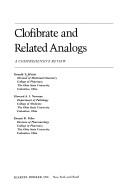| Listing 1 - 3 of 3 |
Sort by
|

ISBN: 0824766814 Year: 1977 Volume: 7 Publisher: New York Dekker
Abstract | Keywords | Export | Availability | Bookmark
 Loading...
Loading...Choose an application
- Reference Manager
- EndNote
- RefWorks (Direct export to RefWorks)
Pathological haematology --- Pharmacology. Therapy --- Pharmacosynthesis. Pharmacochemistry --- Clofibrate --- Antilipemic agents --- Antilipemic Agents --- #Lilly --- Anticholesteremic agents --- Propionates --- Antilipid drugs --- Hypolipemic agents --- Hypolipidemic agents --- Lipid-lowering drugs --- Cardiovascular agents --- Hyperlipidemia --- Chemotherapy --- Hypolipidemic Agents. --- Clofibrate.
Book
ISBN: 1280306297 9786610306299 3540276610 Year: 2005 Publisher: Berlin : Springer,
Abstract | Keywords | Export | Availability | Bookmark
 Loading...
Loading...Choose an application
- Reference Manager
- EndNote
- RefWorks (Direct export to RefWorks)
Cardiovascular diseases continue to be the leading cause of death in the - jority of industrialized countries. The most frequent underlying pathology, namely atherosclerosis, and its clinical sequelae, namely coronary heart d- ease, cerebrovascular disease and peripheral artery disease, remain common although for a long time we have been made aware of avoidable or mo- ?able etiological factors such as smoking, fat-rich diet or lack of exercise, and although these adverse lifestyle factors have been extensively addressed by population-wide primary prevention programs. Cardiovascular morbidity and mortality also remain high despite successful anti-hypertensive and lipid lowering drug therapies which help to reduce cardiovascular morbidity and mortality by about 30% in both secondary and tertiary prevention settings. This can partly be explained by the increasing life expectancy and growing p- portionofelderly people,especiallyinEuropeandNorthAmerica. Inaddition, the World Health Organization makes the alarming prediction that probably in response to the spreading of western dietary behavior and lack of exercise resulting in an increasing prevalence of diabetes, dyslipidemia and hypert- sion, cardiovascular diseases rather than infectious diseases will become the most frequent cause of death worldwide. This volume of the Handbook of Experimental Pharmacology entitled “Atherosclerosis” is divided into four parts and intends to give an overview on the pathogenesis of atherosclerosis, established treatment and prevention regimen, and of perspectives for the development of new treatment modalities.
Antilipemic agents. --- Atherosclerosis. --- Arteriosclerosis --- Antilipid drugs --- Hypolipemic agents --- Hypolipidemic agents --- Lipid-lowering drugs --- Cardiovascular agents --- Hyperlipidemia --- Chemotherapy --- Cardiology. --- Toxicology. --- Angiography. --- Metabolic diseases. --- Pharmacology/Toxicology. --- Angiology. --- Metabolic Diseases. --- Disorders of metabolism --- Metabolic diseases --- Metabolic disorders --- Metabolism, Disorders of --- Diseases --- Blood-vessels --- Diagnosis, Radioscopic --- Radiography, Medical --- Chemicals --- Medicine --- Pharmacology --- Poisoning --- Poisons --- Heart --- Internal medicine --- Radiography --- Toxicology --- Pharmacology. --- Drug effects --- Medical pharmacology --- Medical sciences --- Drugs --- Pharmacy --- Physiological effect
Book
ISBN: 0387571213 3540571213 3642784283 3642784267 Year: 1994 Volume: 109 Publisher: Berlin London Paris Springer Verlag
Abstract | Keywords | Export | Availability | Bookmark
 Loading...
Loading...Choose an application
- Reference Manager
- EndNote
- RefWorks (Direct export to RefWorks)
Coronary Disease --- Hyperlipidemias --- Lipid Metabolism. --- Lipoproteins --- -Antilipemic agents --- Antilipid drugs --- Hypolipemic agents --- Hypolipidemic agents --- Lipid-lowering drugs --- Cardiovascular agents --- Hyperlipidemia --- Lipids --- Proteins --- Metabolism, Lipid --- prevention & control. --- diet therapy. --- drug therapy. --- Metabolism --- -Disorders --- -Chemotherapy --- Chemotherapy --- metabolism --- Antilipemic agents. --- CORONARY DISEASE, prevention and control --- HYPERLIPIDEMIA --- Disorders --- Chemotherapy. --- Treatment. --- preventive & control. --- diet therapy --- drug therapy --- CORONARY DISEASE, prevention and control. --- Metabolism. --- Coronary disease, prevention and control. --- Coronary disease --- Preventive & control. --- Diet therapy. --- Drug therapy. --- Antilipemic agents --- Lipid Metabolism --- Metabolism&delete& --- Disorders&delete& --- Treatment --- prevention & control
| Listing 1 - 3 of 3 |
Sort by
|

 Search
Search Feedback
Feedback About UniCat
About UniCat  Help
Help News
News